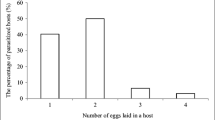Abstract
JapaneseTetranychus urticae is highly variable in diapause traits both among populations from different localities and host plants, as well as within populations. Many southern populations have almost lost their diapause capacity, and those from central Japan (34–37°N) are a mixture of diapausing (DP) and non-diapausing (ND) individuals. A simple mathematical model was constructed for analyzing the conditions under which the ND is more favourable than the DP in a system consisting of two different microhabitats: L, in which winter is lethal for the ND, and O, in which some of the ND can overwinter successfully. The model suggests that if winter mortality is not very high for the ND, and the annual reproductive rate of the ND is higher than that of the DP in microhabitat L, then a higher dispersal rate of the mites from L to O, and an equal number of patches of the two microhabitats will favour the ND more than the DP.
Similar content being viewed by others
References
Goka, K. and Takafuji, A., 1990. Genetical studies on the diapause of the two-spotted spider mite,Tetranychus urticae Koch (1). Appl. Entomol. Zool., 25: 119–125.
Goka, K. and Takafuji, A., 1991. Genetical studies on the diapause of the two-spotted spider mite,Tetranychus urticae Koch (2). Appl. Entomol. Zool., 26: 77–84.
Gotoh, T. and Shinkaji, N., 1981. Critical photoperiod and geographical variation on diapause induction in the two-spotted spider mite,Tetranychus urticae Koch (Acarina: Tetranychidae), in Japan. Jpn. J. Appl. Entomol. Zool., 25: 113–118.
Helle, W., 1968. Genetic variability of photoperiodic response in an arrhenotokous mite (Tetranychus urticae). Entomol. Exp. Appl., 11: 101–113.
So, P.-M. and Takafuji, A., 1991. Coexistence ofTetranychus urticae (Acarina: Tetranychidae) with different capacities for diapause: comparative life-history traits. Oecologia, 87: 146–151.
Takafuji, A. and Kamibayashi, M., 1984. Life cycle of a non-diapausing population of the two-spotted spider mite,Tetranychus urticae Koch in a pear orchard. Res. Popul. Ecol., 26: 113–123.
Takafuji, A., Inoue, M. and Oda, M., 1989. Diapause attributes ofTetranychus urticae populations from Nara Prefecture, Japan. Jpn. J. Appl. Entomol. Zool., 33: 134–139.
Takafuji, A., So, P.-M. and Tsuno, N., 1991. Inter- and intra-population variations in diapause attributes of the two-spotted spider mites,Tetranychus urticae Koch, in Japan. Res. Popul. Ecol., 33: 331–344.
Veerman, A., 1985. Diapause. In: W. Helle and M.W. Sabelis (Editors), Spider Mites: Their Biology, Natural Enemies and Control, Vol. 1A, Elsevier, Amsterdam, pp. 279–316.
Author information
Authors and Affiliations
Additional information
This study was supported in part by a Grant-in Aid (Bio Cosmos Program BCP 92-I-B-3) from the Ministry of Agriculture, Forestry and Fisheries, Japan.
Rights and permissions
About this article
Cite this article
Takafuji, A., Tsuda, Y. Coexistence ofTetranychus urticae with different diapause capacities: a mathematical model. Exp Appl Acarol 14, 251–260 (1992). https://doi.org/10.1007/BF01200567
Issue Date:
DOI: https://doi.org/10.1007/BF01200567




